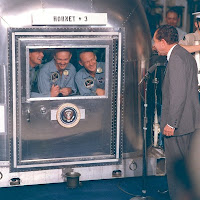Not soon enough.
Crichton was trained as a medical doctor; although he was not a research scientist, he had at least taken a great number of science classes. His pseudoscientific writings, however, disparaged and distorted science at every opportunity.
In Crichton’s 1969 novel The Andromeda Strain, a NASA probe returns to Earth tainted by extraterrestrial germs, which then spark a deadly pandemic. The widespread success of this book sparked fears among the public about the upcoming Apollo 11 lunar mission, and caused the protocols for returning astronauts to change. According to Apollo 11 capsule commander Michael Collins, the lengthy quarantine and isolation protocols the astronauts experienced after returning to Earth were a direct result of public fears stoked by The Andromeda Strain, rather than by NASA’s assessment of the real danger of “space bugs.”
In Crichton’s 1990 book Jurassic Park, rogue geneticists recreate dinosaurs in the eponymous theme park. Although it is possible to extract short, fragmented segments of DNA from recently-dead animals, the scenario of resurrecting dinosaurs by such methods is laughably implausible. One can see the science of
In the 2002 Prey, Crichton’s paranoia about science extends to nanotechnology. Prey tells the story of an evil nanotechnology company whose now-sentient product escapes the confines of its lab and evolves deadly traits. Those mad scientists are off again, ruining the world for everyone else.
All this could be forgiven and dramatic devices for selling novels. However, in State of
Rather than earning Crichton universal ridicule, State of
The Toll of Jenny McCarthy's Anti-Vaccine Pseudoscience
Labels
- scientology (1)